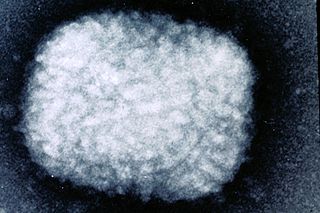
Myxomatosis is a disease caused by Myxoma virus, a poxvirus in the genus Leporipoxvirus. The natural hosts are tapeti in South and Central America, and brush rabbits in North America. The myxoma virus causes only a mild disease in these species, but causes a severe and usually fatal disease in European rabbits. Myxomatosis is an excellent example of what occurs when a virus jumps from a species adapted to the virus to a native host, and has been extensively studied for this reason.. The virus was intentionally introduced in Australia, France, and Chile in the 1950s to control wild European rabbit populations.

Orf is a farmyard pox, a type of zoonosis. It causes small pustules in the skin of primarily sheep and goats, but can also occur on the hands of humans. A pale halo forms around a red centre. It may persist for several weeks before crusting and then either resolves or leaves a hard lump. There is usually only one lesion, but there may be many, and they are not painful. Sometimes there are swollen lymph glands.

Vaccinia virus is a large, complex, enveloped virus belonging to the poxvirus family. It has a linear, double-stranded DNA genome approximately 190 kbp in length, which encodes approximately 250 genes. The dimensions of the virion are roughly 360 × 270 × 250 nm, with a mass of approximately 5–10 fg. The vaccinia virus is the source of the modern smallpox vaccine, which the World Health Organization (WHO) used to eradicate smallpox in a global vaccination campaign in 1958–1977. Although smallpox no longer exists in the wild, vaccinia virus is still studied widely by scientists as a tool for gene therapy and genetic engineering.

Poxviridae is a family of double-stranded DNA viruses. Vertebrates and arthropods serve as natural hosts. There are currently 83 species in this family, divided among 22 genera, which are divided into two subfamilies. Diseases associated with this family include smallpox.
Orthopoxvirus is a genus of viruses in the family Poxviridae and subfamily Chordopoxvirinae. Vertebrates, including mammals and humans, and arthropods serve as natural hosts. There are 12 species in this genus. Diseases associated with this genus include smallpox, cowpox, horsepox, camelpox, and mpox. The most widely known member of the genus is Variola virus, which causes smallpox. It was eradicated globally by 1977, through the use of Vaccinia virus as a vaccine. The most recently described species is the Alaskapox virus, first isolated in 2015.

Camelpox is a disease of camels caused by the camelpox virus (CMPV) of the family Poxviridae, subfamily Chordopoxvirinae, and the genus Orthopoxvirus. It causes skin lesions and a generalized infection. Approximately 25% of young camels that become infected will die from the disease, while infection in older camels is generally more mild. Although rare, the infection may spread to the hands of those that work closely with camels.

Bovine papular stomatitis is a farmyard pox caused by Bovine papular stomatitis virus (BPSV), which can spread from infected cattle to cause disease in milkers, farmers and veterinarians. Generally there is usually one or a few skin lesions typically on the hands or forearm. The disease is generally mild.

Murine coronavirus (M-CoV) is a virus in the genus Betacoronavirus that infects mice. Belonging to the subgenus Embecovirus, murine coronavirus strains are enterotropic or polytropic. Enterotropic strains include mouse hepatitis virus (MHV) strains D, Y, RI, and DVIM, whereas polytropic strains, such as JHM and A59, primarily cause hepatitis, enteritis, and encephalitis. Murine coronavirus is an important pathogen in the laboratory mouse and the laboratory rat. It is the most studied coronavirus in animals other than humans, and has been used as an animal disease model for many virological and clinical studies.

Molluscum contagiosum virus (MCV) is a species of DNA poxvirus that causes the human skin infection molluscum contagiosum. Molluscum contagiosum affects about 200,000 people a year, about 1% of all diagnosed skin diseases. Diagnosis is based on the size and shape of the skin lesions and can be confirmed with a biopsy, as the virus cannot be routinely cultured. Molluscum contagiosum virus is the only species in the genus Molluscipoxvirus. MCV is a member of the subfamily Chordopoxvirinae of family Poxviridae. Other commonly known viruses that reside in the subfamily Chordopoxvirinae are variola virus and monkeypox virus.

Lumpy skin disease (LSD) is an infectious disease in cattle caused by a virus of the family Poxviridae, also known as Neethling virus. The disease is characterized by large fever, enlarged superficial lymph nodes and multiple nodules on the skin and mucous membranes. Infected cattle also may develop edematous swelling in their limbs and exhibit lameness. The virus has important economic implications since affected animals tend to have permanent damage to their skin, lowering the commercial value of their hide. Additionally, the disease often results in chronic debility, reduced milk production, poor growth, infertility, abortion, and sometimes death.

Fowlpox is the worldwide disease of poultry caused by viruses of the family Poxviridae and the genus Avipoxvirus. The viruses causing fowlpox are distinct from one another but antigenically similar, possible hosts including chickens, turkeys, quail, canaries, pigeons, and many other species of birds. There are two forms of the disease. The first is spread by biting insects and wound contamination, and causes lesions on the comb, wattles, and beak. Birds affected by this form usually recover within a few weeks. The second is contracted by inhalation or ingestion of the virus via dust or aerosols, leading to the 'diphtheritic form' of the disease, in which diphtheritic membranes form in the mouth, pharynx, larynx, and sometimes the trachea. The prognosis for this form is poor.

Canarypox virus (CNPV) is an Avipoxvirus and etiologic agent of canarypox, a disease of wild and captive birds that can cause significant losses. Canarypox can enter human cells, but it cannot survive and multiply in human cells. There is a live viral vaccine available which may have beneficial properties against human cancer when used as a mammalian expression vector.. Furthermore, the POXIMUNE® C vaccine does offer direct protection against CNPV in susceptible birds.
Avipoxvirus is a genus of viruses within the family Poxviridae. Poxviridae is the family of viruses which cause the afflicted organism to have poxes as a symptom. Poxviruses have generally large genomes, and other such examples include smallpox and monkeypox. Members of the genus Avipoxvirus infect specifically birds. Avipoxviruses are unable to complete their replication cycle in non-avian species. Although it is comparably slow-spreading, Avipoxvirus is known to cause symptoms like pustules full of pus lining the skin and diphtheria-like symptoms. These diphtheria-like symptoms might include diphtheric necrotic membranes lining the mouth and the upper respiratory tract. Like other avian viruses, it can be transmitted through vectors mechanically such as through mosquitoes. There is no evidence that this virus can infect humans.

Veterinary virology is the study of viruses in non-human animals. It is an important branch of veterinary medicine.
Turkeypox virus is a virus of the family Poxviridae and the genus Avipoxvirus that causes turkeypox. It is one of the most common diseases in the wild turkey population. Turkeypox, like all avipoxviruses, is transmitted either through skin contact or by arthropods acting as mechanical vectors.

The monkeypox virus, is a species of double-stranded DNA virus that causes mpox disease in humans and other mammals. The monkeypox virus is a zoonotic virus belonging to the orthopoxvirus genus, making it closely related to the variola (VARV), cowpox (CPX), and vaccinia (VACV) viruses. MPV is oval-shaped with a lipoprotein outer membrane. The genome is approximately 190 kb.
Suipoxvirus is a genus of viruses in the family Poxviridae and subfamily Chordopoxvirinae. Swine serve as natural hosts. There is only one species in this genus: Swinepox virus. Diseases associated with this genus include asymptomatic skin disease.
Pseudocowpox is a disease caused by the Paravaccinia virus or Pseudocowpox virus, a virus of the family Poxviridae and the genus Parapoxvirus. Humans can contract the virus from contact with livestock infected with Bovine papular stomatitis and the disease is common among ranchers, milkers, and veterinarians. Infection in humans will present with fever, fatigue, and lesion on the skin.
Raccoonpox virus (RCN) is a double-stranded DNA virus and a member of the orthopoxviruses in the family Poxviridae and subfamily Chordopoxvirinae which consists of eight genera: Avipoxvirus, Capripoxvirus, Leporipoxvirus, Molluscipoxvirus, Orthopoxvirus, Parapoxvirus, Suipoxvirus and Yatapoxvirus Vertebrates are the natural host of Chordopoxvirinae subfamily viruses. More specifically, raccoons are the natural hosts of RCN. RCN was isolated in 1961 from the upper respiratory tissues of 2 raccoons in a group of 92 observably healthy raccoons trapped close to Aberdeen, Maryland.

In 1964 there was an outbreak of monkeypox at Rotterdam Zoo, where two Central/South American giant anteaters were first identified with the disease. Until then, monkeypox was thought to occur only in primates. Housed in one large enclosure, the monkeypox virus subsequently spread to several orangutans, chimpanzees, gorillas, guenons, squirrel monkeys, macaques, marmosets and gibbons.














